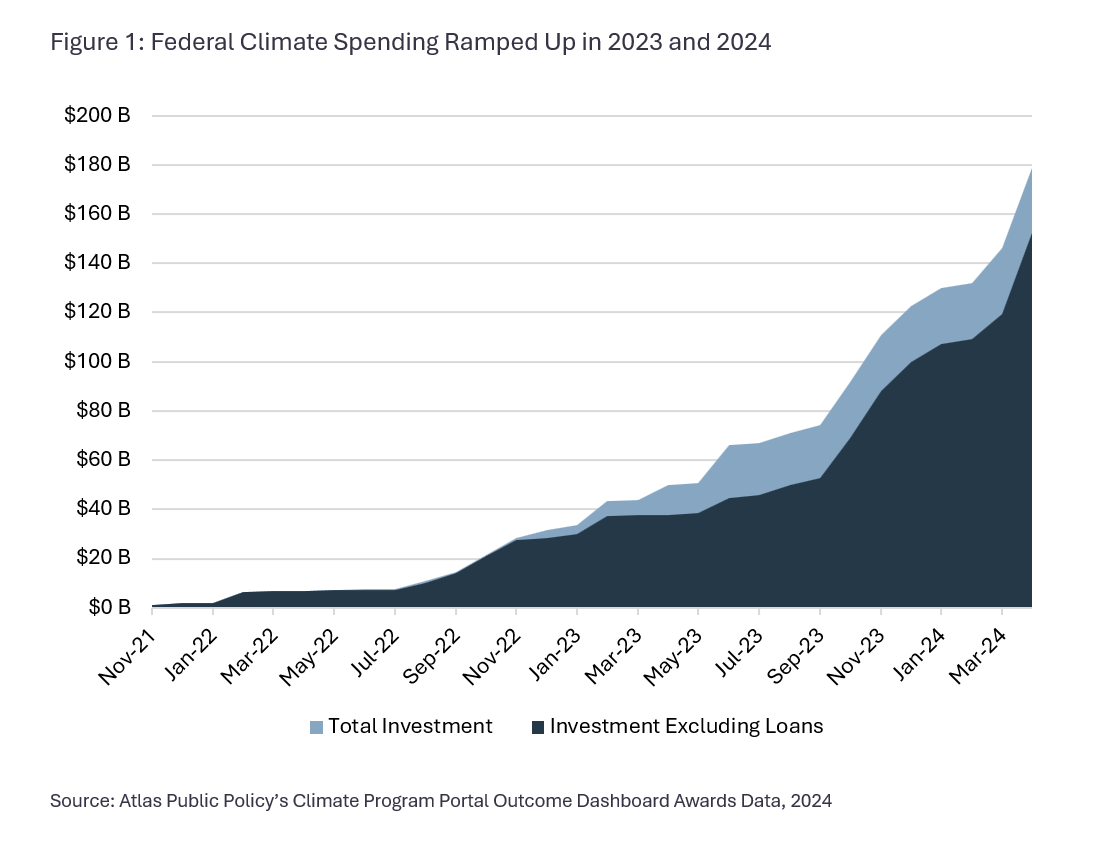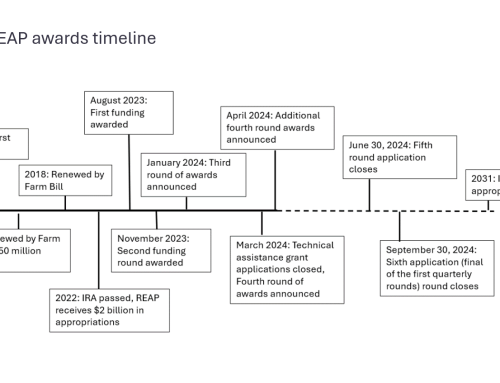
Federal agencies are ramping up their rollout of the climate programs from the Infrastructure Investment and Jobs Act (IIJA) and the Inflation Reduction Act (IRA). In this Spotlight, we will cover key developments from 2023, some updates from 2024, and provide a breakdown by state of funding awarded. This analysis draws on data from our forthcoming Annual Report. For a deep dive into key programs, check out last month’s Spotlight here.
2023 was a watershed year for federal climate action. In 2023, as tracked on the Climate Program Portal’s Outcomes Dashboard, federal agencies announced $74 billion in funding for climate programs, nearly tripling the total from 2022 ($29 billion). The majority of 2023’s climate funding went to transit and rail projects, followed by electrification projects like purchasing battery-electric buses and charging equipment, and hydrogen. The most significant portion of this funding was awarded under two large competitive IIJA programs: the Federal-State Partnership for Intercity Passenger Rail Grant Program and the Regional Clean Hydrogen Hubs. Through December 2023, nearly 100 climate-related programs had issued 158 funding awards, supporting about 8,000 projects in all 50 states, the District of Columbia, and seven U.S. territories.
The increasing pace of investment continues into 2024 as federal agencies have already announced $45 billion. The laws appropriate $373.8 billion for climate programs (excluding tax credits and loans). Through May 8, 2024, agencies have announced $150 billion, meaning that 40 percent of climate funding has been announced.
Figure 2: Federal Climate Investments by State in 2023
New York, California, Maryland, Texas, and Nevada took the lead in climate investments for 2023, supporting projects ranging from rail infrastructure enhancements to clean energy initiatives. Wyoming, Maryland, Nevada, Alaska, and North Dakota received the highest per capita investments, with projects including clean energy demonstrations, climate resilience improvements, and carbon capture initiatives.
Most of New York, California, Maryland, and Nevada’s investments come from the Intercity Passenger Rail Grant Program. The IIJA is allocating $24.6 billion to this program – the single largest investment by a single program in that legislation. New York received four intercity passenger rail grants with the largest being the Hudson River Tunnel rehabilitation project. California received $3.1 billion for a section of its inaugural high-speed rail service project (see last month’s Spotlight to learn more). Maryland received six grants, five of which total $7 billion in awards and one $21 million grant that is split regionally across the Mid-Atlantic states, to support Amtrak’s various rail tunnel replacement projects. Nevada received $3 billion for its Brightline West High-Speed Project, a 218-mile passenger rail system connecting Las Vegas to Southern California.
More than half of Wyoming’s 2023 investments came from the $1.3 billion grant to TerraPower to develop the Natrium Reactor Demonstration Project in Kemmerer. The project is being funded by the Department of Energy’s (DOE) Advanced Reactor Demonstration Program. The demonstration plant is expected to bring 1,600 construction jobs and 250 full-time positions. It is also being built adjacent to a retiring coal facility, making it a test case of the type of clean energy projects in existing energy communities necessary to achieve a just transition.
Alaska received nearly $700 million in federal grants in 2023, including $206 million to the Alaska Energy Authority for the Railbelt Innovative Resiliency Project, $46 million to the Alaska Department of Transportation and Public Facilities to add an electric ferry to the Alaska ferry system, and $36 million to Westinghouse Electric Company to build a Long-Duration Energy Storage Demonstration project in Healy, Alaska. In North Dakota, a significant share of federal funding supported a new Carbon Capture Demonstration project in Center, North Dakota. The project will be constructed next to a coal-fired power plant and will capture up to four million tons of CO2 annually from the power plant.
There is a lot to look forward to in 2024 as the implementation of the IIJA and IRA continues, especially with the upcoming Presidential election in November. First is the dissemination of the $27 billion Greenhouse Gas Reduction Fund. As of April 2024, all the funding for this program has been announced, with $20 billion awarded under the National Clean Investment Fund and Clean Communities Investment Accelerator, and $7 billion in Solar for All awards – however it is unclear when this funding will start to make its way into grants and loans around the country. There is also the likely historic uptake of clean energy tax credits by entities without a tax burden thanks to the IRA’s Direct Pay/Elective Pay mechanism. Another program to look out for is the $5 billion Climate Pollution Reduction Grants (CPRG) that will support states, local governments, Tribes, and territories as they begin implementing their newly drafted Priority Climate Action Plans (PCAPs). The program disseminated planning grants last year, and states submitted PCAPs in March and submitted proposals for implementation grants in April. The implementation grants are the bulk of the funding with approximately $4.3 billion going to states and cities, and $300 million going to Tribes and territories. Finally, states are gearing up to launch their Home Energy Rebate, which will allocate nearly $9 billion nationwide to support energy-saving retrofits and building electrification. So far, 14 states have submitted their plans.
We will be keeping an eye on the progress of these programs on the Outcomes Dashboard.


